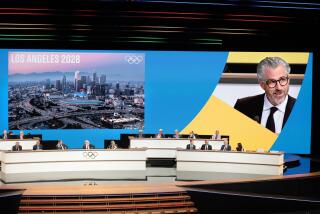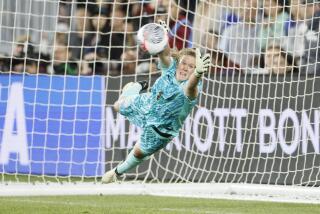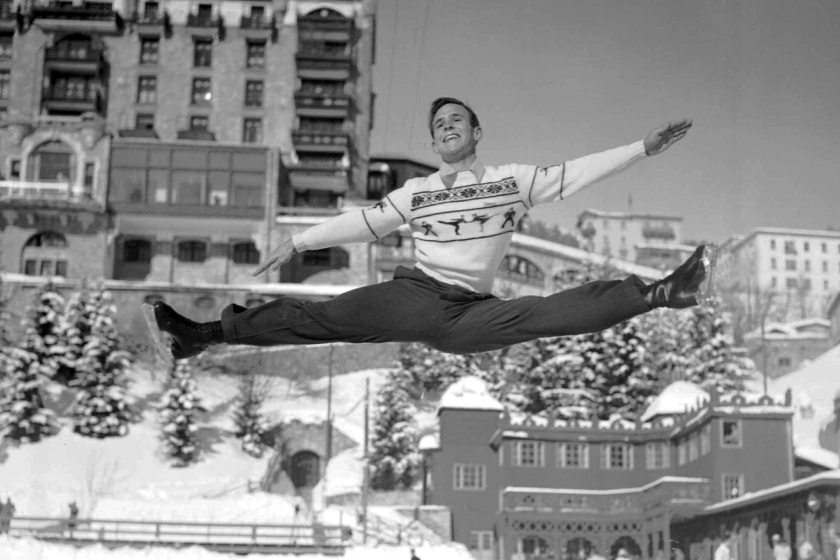TAKING A POWDER
- Share via
Before Picabo Street and the dawning of the new age of Aquarius in women’s alpine skiing, she was America’s next rising star.
Julie Parisien reigned as the world’s top female slalom skier before a second-run slalom meltdown at the 1992 Albertville Olympics cost her the gold medal and triggered a slippery slope career slide that hit hay bales last spring, when Parisien contemplated a mutinous act.
Consider, though, her state of mind:
In the five years after Albertville, her brother was killed by a drunk driver, her Lillehammer comeback ended in an emotional breakdown and her God-given skiing skills betrayed her--leading to a bitter parting from the U.S. ski team at 22.
But a traitor?
“I didn’t really want to be a turncoat,” Parisien said of what she tried to do.
Parisien quit the U.S. team after the 1994 Olympics had ended in failure and friction. She blasted her coaches, then broke down in her room before a post-Olympic ski race at Mammoth the week her brother’s killer was to be sentenced for manslaughter.
“I just said, ‘God, I’m falling apart,’ ” Parisien recalled.
She sought refuge in the World Pro Tour and, for three seasons, dominated against inferior competition, cashing checks as she collected herself.
Her former coach said at the time that the tour was for “has-beens.”
Knowing she was no has-been, Parisien made two ill-fated attempts to return to the U.S. ski team--in the summer of 1995 and the fall of ‘96--but sensed she wasn’t wanted.
Rumors circulated that she was jealous of Street, who had become an international superstar in Parisien’s absence, winning two World Cup downhill titles and earning a Nike endorsement.
“Silly, impossible things,” Parisien said of the rumors, one of which suggested that she was out to steal Street’s Nike deal. “They doubted me. I doubted them.”
So, last spring, Parisien made a run for the border. Raised in Maine but Canadian born, she inquired about skiing for Canada in the 1998 Nagano Games.
Bill Marolt, the ski team’s new CEO, defiantly denied her request for a release.
U.S. women’s Coach Herwig Demschar explained, “It’s like you were working for United Airlines and they trained you as a pilot and paid for your training. The U.S. ski team invested a lot of money in her. So I would say that it’s the right approach not to let the athlete out. If she wants to ski race, she should ski with the United States.”
Parisien cursed the decision--”Where does this guy Marolt get off?” she said--until a September meeting between them was arranged.
They emerged with new plan. Parisien would be given a chance to earn a spot on the team, provided she pay her own way--meals, travel, lodging, lift tickets--with the money she had earned as a professional.
At the ski team’s November training camp in Beaver Creek, Colo., Parisien was listed on the C team.
Because she was away three years, she had to spend December accumulating necessary International Ski Federation (FIS) points in U.S. Nor-Am races, skiing’s equivalent to working yourself back up from triple A.
To compete on the World Cup circuit, she must be ranked among the top skiers when the new points list comes out Jan. 1. If, as expected, Parisien earns enough points, she will have a month before Nagano to hone her skills against Olympic competition.
U.S. ski team officials reported this week that Parisien is “right on track.”
Saddled with lowly start positions, Parisien finished 15th in a recent slalom at a Nor-Am in Loveland, Colo., and fourth in a giant slalom at Breckenridge, Colo.
She can earn an automatic Olympic berth by winning the super-giant slalom at next week’s U.S. ski team Gold Cup at Lake Placid, N.Y.
Such is the state of a very young U.S. women’s team that Parisien has instantly become an Olympic medal wild card, a gifted skier who has matured from a slalom specialist into a four-event threat.
“It’s tough politically for the team,” Parisien, only 26, admitted. “I’d obviously be taking a young girl’s spot. If I deserve it, that’s the way it goes.”
Parisien might not have been able to return had the team not undergone a dramatic overhaul--coaches and skiers--since Lillehammer.
“The whole office has changed a lot,” said Demschar, who was recruited from Austria after Lillehammer to coach the U.S. women. “There’s been no serious eruptions for 12 months. This is something that’s not happened before. We had five CEOs in three years. Nothing great can happen if you don’t have stability.”
Parisien did not get along with the former alpine staff and still accuses her coaches of acute insensitivity after the death of her brother Jean-Paul, killed in an auto accident near her family’s home in Auburn, Maine, in December 1992.
“Some of the coaches would say crass things, like, ‘You think you’re the only person who has suffered?’ ” Parisien said. “That really hurt a lot. Now, it’s a fresh slate.”
Demschar says obvious talents must be treated differently.
“If you have an athlete going 90 mph downhill, when they get to the bottom, they’re not normal,” he said. “They’re like artists, painters. In my opinion, we have to treat them with this idea.”
Parisien has also received an important endorsement from Street, whose silver-medal Olympic opinion counts.
“I think there’s enough room for everybody at the top,” Street said.
More than anyone, perhaps, Street understands Parisien’s pain.
They were together at a race in Lake Louise, Canada, when word arrived of J.P. Parisien’s death.
“I went through that with her,” Street said. “I was there the night we got the call. I was in her room, and packed her up and sent her home. That started the whole thing for her. I felt she was robbed out of her time.”
Street, 27, says the veteran Parisien can add valuable leadership to a U.S. team that became even younger with the retirement of Hilary Lindh, who went out on top after winning the 1997 world downhill championship.
“She’s very strong, very professional and knows the ropes,” Street said of Parisien.
Street says the dynamics of the team have changed.
“Three years ago, they would have been slamming doors and locking each other out of the room,” she said of her teammates. “But now, it’s such a young, positive, friendly atmosphere here.”
There is no doubt envy played a part in Parisien’s return. There was a time Parisien was a superior prospect to the precocious Picabo.
“Five years ago, I was beating her consistently in downhills,” Parisien said. “It was kind of intriguing. I was beating her in super-G’s 2 1/2 years before I left. That definitely is a bit of it, but I’m not here to compete with Picabo. She’s done so many amazing things.”
While Parisien was winning two pro tour titles in three seasons, Street became a dominant force on the World Cup circuit, adding a 1996 world downhill championship to her list--before a knee injury wiped out her 1997 season.
“It’s not just the Olympics,” Parisien said. “It’s a quest to come back and race really well again. Realistically, my chance to medal is as good as anyone else’s. I definitely have faith in my ability to do it.”
Parisien is also out to salve her 1992 Olympic disappointment in France on the slopes of Meribel.
She led all competitors after her first slalom run but played it too safe on her afternoon run, finishing fourth by five-hundredths of a second.
“I just wanted to kill myself,” she said of that memory. “If I only knew then what I know now.”
More to Read
Go beyond the scoreboard
Get the latest on L.A.'s teams in the daily Sports Report newsletter.
You may occasionally receive promotional content from the Los Angeles Times.







